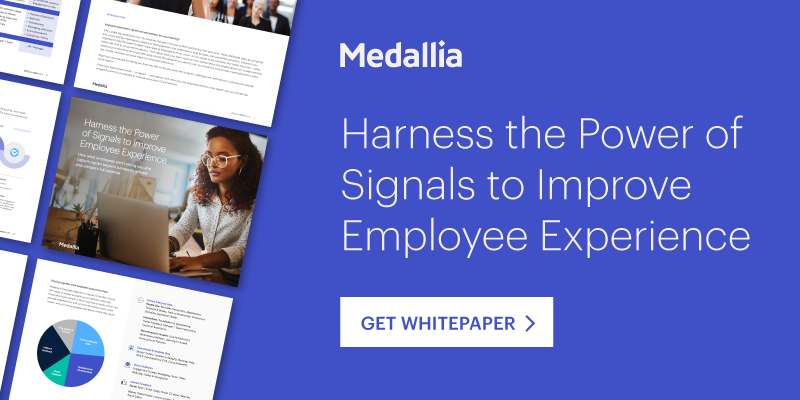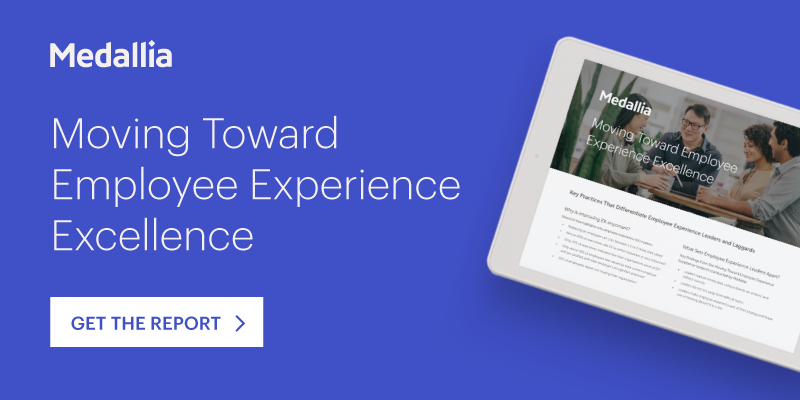Building a Better Employee Experience Strategy
February 8, 2022
Employee Experience
Just 20% of employees strongly believe that their performance is managed in a way that motivates them to do their best work. Since a significant part of leadership is to inspire and motivate people, that’s both a disappointing and shocking fact.
Every company has its own culture, which can either be positive or negative. Culture is created in the everyday experiences employees have within your organization and with their managers and teams. It takes a conscious effort to create the right company culture to motivate and inspire people. Business leaders and HR leaders not only need to proactively create the right company culture, but they also need to monitor, measure, and nurture their employee experience strategy.
What is an employee experience strategy?
An employee experience strategy (EX strategy) is an organization’s plan and process for enhancing the experience and skills of its employees culturally, physically, and technologically. In other words, providing a welcoming and comfortable worksite, a culture that aligns with their values, and the tech resources they need to do their job.
Many companies today invest in customer experience. They probe to learn about customer satisfaction and use qualitative and quantitative measures, such as customer satisfaction scores (CSAT) and net promoter scores (NPS), to rate customer interactions. However, fewer organizations employ the same strategy to the employee experience.
Yet, the two — customer experience and employee experience — are firmly linked. Organizations that score high on employee satisfaction also score high on customer satisfaction.
A study in the Harvard Business Review analyzed hundreds of thousands of customer reviews from the American Customer Satisfaction Index (ACSI) and compared them to employee satisfaction reviews on Glassdoor. The study revealed that every additional star employees gave their company for overall satisfaction corresponded to a 1.3% improvement in customer satisfaction scores. While that may not sound like a big improvement at first glance, a Journal of Marketing study found that a 1% improvement in ACSI scores can boost overall market value by 4.6%. That is significant.
When your team members have a great experience at work, your customers benefit — and so does the bottom line.
Why an employee experience strategy is crucial
While many top-performing companies have a strong employee experience strategy in place, the majority of organizations continue to struggle with their EX strategy. For example, when employees were surveyed about whether they were satisfied with the workflow and technology being employed at their job, the results were a resounding no.
- 38% said they were satisfied or very satisfied with the tools and tech they had to do their job.
- 42% said they were satisfied or very satisfied with the daily workflow.
- 38% said they were satisfied or very satisfied with the autonomy needed to make decisions.
- 41% said they were satisfied or very satisfied with the access they had to relevant data and information they needed to do their jobs.
- 49% said they were satisfied or very satisfied with the overall job design.
Less than half of the companies in the survey expressed high levels of employee satisfaction. In an era where we are seeing mass turnover and an exceptionally challenging marketplace for new hires, improving the employee experience is essential for success.
Designing an employee experience strategy
Happy employees are more productive, but your employee experience strategy needs to be about more than just keeping your employees happy to achieve long-term benefits.
To implement an effective employee experience strategy, each of these four areas must be aligned:
Clear philosophy
Your employee experience strategy needs to clearly define the employee experience and its relationship to engagement.
Supportive culture
The culture must be grounded in employee-centric values that reinforce your key behaviors, such as collaboration, transparency, safety, alignment, and feedback.
Articulated accountability
Companies cannot delegate employee experience to the HR department or HR leaders. It must be a holistic approach with shared responsibilities among senior leaders, managers, and employees to provide meaningful feedback.
Aligned measurement
Companies need to continuously measure and evaluate employee experience using a clear data analytics strategy. Continuously measuring employee experience throughout the employee life cycle provides the feedback companies need to ensure alignment with goals and objectives.
Measurement does not mean just taking an annual employee survey. You need real-time feedback that makes it easy for companies to optimize performance in the moment.
A step-by-step guide to creating an effective employee experience strategy
Designing an employee experience feedback strategy requires a careful examination of what you are doing currently and a commitment to making the necessary changes to improve.
Step one: Survey at the right time
Start by analyzing the current environment by listening to your employees. Creating employee surveys or holding information sessions focusing on the three pillars of employee experience. You need to understand the current way employees feel about the cultural, physical, and technological environment in your organization.
Probe for employee perceptions of:
- Company culture: How workers feel about the organizational structure, mission, leadership style, compensation, benefits, etc.
- Physical: How workers feel about their workplace environment, such as office space, desks, chairs, common areas, etc.
- Technology: How workers feel about the technology they use to do their jobs.
Step two: Communicate the purpose of each survey
When sending out the survey, be sure to communicate the purpose of collecting information regarding company culture, feelings towards the physical workplace environment, or technology and training. Approach communication with compassion so as to create a safe space where employees can provide clear and honest feedback. And be transparent and proactive about how the feedback will be used, as employees will be less likely to participate if their feedback won’t be used to produce a better work experience.
Step three: Streamline and centralize all surveys
Understand what concepts go together so that you can include them in the same survey and minimize the amount of energy an employee needs to invest in completing feedback for your company. Conversely, understand what themes and topics deserve its own survey so employees don’t invest time into feedback that doesn’t pertain to them.
Step four: Define objectives to keep surveys concise and targeted
Now, it’s time to set your objectives for improving the employee experience. You will be setting goals for improvement, defining a strategy for execution, and setting up a formal system for tracking your progress. Having objectives will help you choose which questions and information need to be included on your survey in order to meet these goals. This will additionally improve your employees’ experiences with taking your survey, minimizing the potential for incomplete feedback due to abandoning a survey early on in the process.
Step five: Take action based on results
This is a crucial step that is often overlooked by leadership. Ensure that your organization is committed to taking action in a timely manner. When action isn’t taken, employees lose trust in the organization.
Step six: Communicate action and continue to measure
Gauging employee experience may have started with taking a snapshot of where your organization was at that time, but you need to continue to measure progress against your goals. Employees may be excited when they begin a new job or complete their first project, but that enthusiasm may wane with more time on the job.
Identify a process for not only measuring feedback but for reiterating results to employees. Remember, employees are more likely to participate if they know the time and energy they invest into providing honesty will translate into an improved work experience. Be transparent about your findings and what you are actively doing in terms of strategy to rectify concerns.
Continue investing in your employee experience
Every company and person is different, so there is no perfect employee experience strategy covering every situation. However, you can build a foundation that allows you to create a better work environment and foster employee engagement. From that foundation, you can personalize the employee’s journey and continue nurturing a positive employee experience. When you get it right, it sets the stage for success.
Looking to learn more about creating a positive employee experience? Download The Definitive Guide to Employee Experience.








